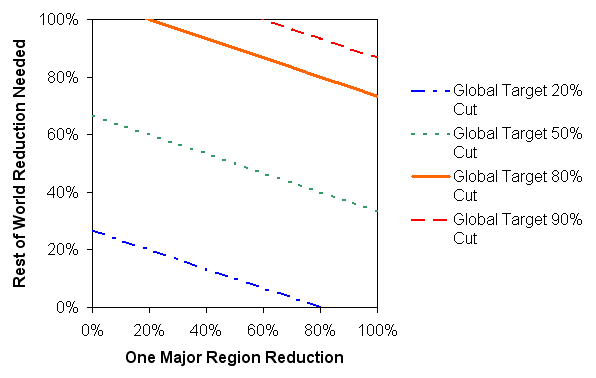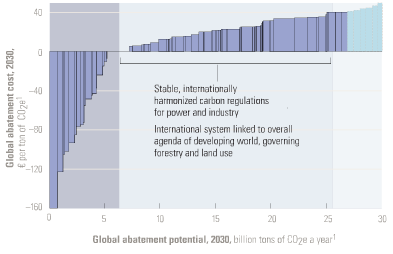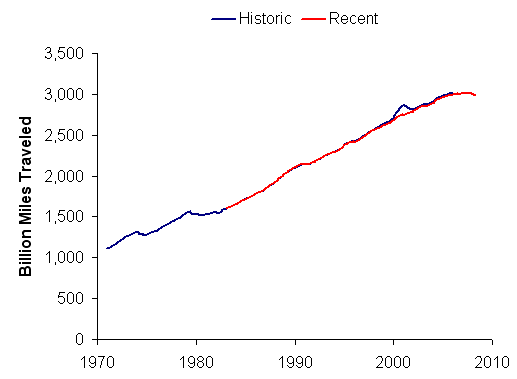A fundamental tension in the war game arose from the fact that, regardless of development and equity considerations, all large nations would have to make cuts eventually, because there simply isn’t enough atmosphere to go around. Consider the following graph, showing the tradeoff in emissions cuts for a two-region world.

The x-axis shows the size of emissions reductions in a major region, representing a quarter of business as usual emissions (think US or China). The y-axis shows how much the rest of the world would have to cut to meet a global target, given the action of the first region. You can see from the solid orange line that meeting an 80% global cut requires at least a 20% cut from the major region. Otherwise, it’s not physically possible to balance the carbon account (unless free-air capture, a thermodynamic loser, becomes viable). A global target of a 90% cut from current levels – not an implausible requirement in the long run – requires at least 60% participation from the major nation above. Clearly the developing country position of do-nothing-but-grow can be no more than a transient if we are to make real progress on mitigation.
Author: Tom
Climate War Game – Is 2050 Temperature Locked In?
This slide became known as “the Angry Red Future” at the war game:
Source: ORNL & Pew via Nature In the Field
After seeing the presentation around it, Eli Kintisch of Science asked me whether it was realistic to assume that 2050 climate is already locked in. (Keep in mind that we were living in 2015.) I guessed yes, then quickly ran a few simulations to verify. Then I lost my train of thought and lost track of Eli. So, for what it’s still worth, here’s the answer.
Continue reading “Climate War Game – Is 2050 Temperature Locked In?”
Climate War Game – Takeaways
Over breakfast this morning (day three), I heard from several participants that the war game was “too easy” – that is, negotiators were too free to agree to aggressive commitments which their real-world constituents or bosses wouldn’t support. That wasn’t my observation in the China team room, and in closing statements it seemed that teams were taking their roles very seriously indeed. It’s not quite the Zimbardo Prison Experiment but it’s very real in some ways.
The following are some of the more poignant comments from players, with a little editorial license on my part. Hopefully I have attributions and the general drift correct; please comment if I don’t. (Actually, please comment either way!). I’ve colored a few points that I regard as particularly critical.
It was a little surprising that teams didn’t resist the underlying scenario of the game, which includes an aggressive 80% reduction from 2005 emissions by 2050. This may have been a recognition of the critical need, pointed out by Sharon Burke, to look past what is politically feasible and keep the real goal in sight (i.e. emissions that will achieve stable climate).
Climate War Game – Model Support
Drew Jones of the Sustainability Institute stumbled on a great opportunity for model-based decision support. There are lots of climate models and integrated assessment models, but they’re almost always used offline. That is, modelers work between negotiations to develop analyses that (hopefully) address decision makers’ questions, but during any given meeting, negotiators rely on their mental models and static briefing materials. It’s a bit like training pilots in a flight simulator, then having them talk on the radio to guide a novice, who flies the real plane without instruments.
Tangible Models
MIT researchers have developed a cool digital drawing board that simulates the physics of simple systems:
You can play with something like this with Crayon Physics or Magic Pen. Digital physics works because the laws involved are fairly simple, though the math behind one of these simulations might appear daunting. More importantly, they are well understood and universally agreed upon (except perhaps among perpetual motion advocates).
I’d like to have the equivalent of the digital drawing board for the public policy and business strategy space: a fluid, intuitive tool that translates assumptions into realistic consequences. The challenge is that there is no general agreement on the rules by which organizations and societies work. Frequently there is not even a clear problem statement and common definition of important variables.
However, in most domains, it is possible to identify and simulate the “physics” of a social system in a useful way. The task is particularly straightforward in cases where the social system is managing an underlying physical system that obeys predictable laws (e.g., if there’s no soup on the shelf, you can’t sell any soup). Jim Hines and MIT Media Lab researchers translated that opportunity into a digital whiteboard for supply chains, using a TUI (tangible user interface). Here’s a demonstration:
There are actually two innovations here. First, the structure of a supply chain has been reduced to a set of abstractions (inventories, connections via shipment and order flows, etc.) that make it possible to assemble one tinker-toy style using simple objects on the board. These abstractions eliminate some of the grunt work of specifying the structure of a system, enabling what Jim calls “modeling at conversation speed”. Second, assumptions, like the target stock or inventory coverage at a node in the supply chain, are tied to controls (wheels) that allow the user to vary them and see the consequences in real time (as with Vensim’s Synthesim). Getting the simulation off a single computer screen and into a tangible work environment opens up great opportunities for collaborative exploration and design of systems. Cool.
Next step: create tangible, shareable, fast tools for uncertain dynamic tasks like managing the social security trust fund or climate policy.
Climate War Game – Coverage
Jeff Tollefson has great coverage of the Clout & Climate Change war game at Nature – In the Field.
CNAS has set up a web site for the game, which will include materials and a podcast of Rajendra Pachauri’s keynote.
Update 8/4/2008
Remarks from Rajendra Pachauri and Diana Farrell are now on the CNAS web site.
ORNL has a site documenting the scientific input to the scenarios, here.
Update 8/6/2008
ABC was covering the war game, as part of Earth 2100.
Update 9/24/2008
Drew Jones has an entry at Climate Interactive.
Drilling in America
I don’t usually have TV, but I’m in a hotel tonight. I just saw a McCain ad that would be funny if it weren’t serious. It starts with some blather about high gas prices, and a picture of an old pump (designed to trigger nostalgia for 25 cents a gallon?). It goes on to imply that domestic drilling is the oil security answer. Then it makes the really amazing assertion (“you know who’s to blame”) that the only thing standing in the way of domestic drilling is … Obama. Wow … I had no idea that one senator could single-handedly wield such power.
Climate War Game – A Free Lunch
I’m at CNAS’ climate war game listening to Diana Farrell from the McKinsey Global Institute. So far my takeaway from the exercise has been rather gloomy; Farrell presented a more hopeful view, informed by McKinsey’s construction of supply curves for carbon emissions reductions. I found her opening point particulaly critical: don’t wait for energy supply-side silver bullets to save us, when there are demand-side opportunities now.
McKinsey’s supply curves (and others from bottom-up modeling efforts) indicate large reductions available at low or negative cost. The idea of cheap negawatts has been around for a long time. Hard line economists have also been declaring the idea dead for a long time (see my old bibliography of the top-down/bottom-up debate).
Climate War Game – First Salvo
Sunday evening I attended the kickoff of a CNAS war game, Clout & Climate Change, examining the intersection of climate policy and national security. I’m on the science advisory team, along with Drew Jones and Lori Siegel from the Sustainability Institute. We hope to provide real-time, model-based decision support. The exercise brings together a rather extraordinary talent pool, so it’s a daunting task.
Peter Schwartz delivered an opening talk on scenario planning; he made a compelling case for robust thinking. He also set a tone that has haunted much of the subsequent proceedings: there are striking technological options for dealing with climate, but progress is difficult because people are caught up in their individual worlds (they want more stuff). As a result, he expects that lots of adaptation will be needed. Negotiations since have borne out his framing: aggressive targets (-80% by 2050) appear elusive in the face of the perceived need for continued economic growth to keep US and EU workers happy, avoid regime change in China, and provide for development in the poorest regions.
Paty Romero-Lankao asked the key question of the evening. To paraphrase crudely, she wondered whether a focus on technology and adaptation missed the point; that one must also address the lifestyle issues that are the underlying driver of growth. Amen. Lifestyle is a tougher nut to crack than technology, but to borrow Peter’s phrase guiding scenario planning, it’s important to avoid thinking, “that can’t happen.”
Transportation Developments
GreenCarCongress has some interesting tidbits of recent data: vehicle miles traveled is down and sales of cars surpass trucks, reversing long run trends. An interesting side effect of diminished driving and fuel use is that less money goes into the federal Highway Trust Fund. Because a small portion funds transit, this pulls the rug out from under alternative modes just when they’re needed. I immediately wondered whether the recent falloff in VMT is similar to what happened around the 1973 and 1979 oil price spikes. DOT’s Traffic Volume Trends data provides the answer, if you add historic archive data to recent reports:


